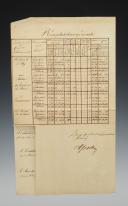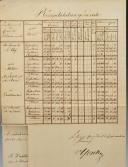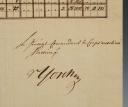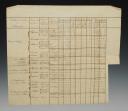
Grande Armée. DETAILED SUMMARY OF THE PRUSSIAN AUXILIARY CORPS, SIGNED BY GENERAL COMMANDER YORCK. 18906-11
Sold out
Grande Armée. DETAILED TABLE SUMMARIZING THE PRUSSIAN AUXILIARY CORPS, SIGNED BY GENERAL COMMANDER YORCK. 18906-11
Two-page table listing:
"location of corps and detachments, denomination by branch, present under arms (men and horses), in hospitals, prisoners of war, on leave, missing, in judgment, total number of men and horses."
First page: "General recap", signed by General Yorck, for 5 locations: St Oleÿ / near Mitau / A Schlock and Ste Anne / at Dahlkirchen / at Memel and Libau.
Signed "The General Commanding the Prussian Auxiliary Corps Yorck".
The second page of the table details each location of corps and detachment by designation of battalions and regiments.
Unfolded document: H 36.5 cm, width 37.5 cm.
In fairly good condition, folds, tear at one fold, a piece of the page cut out without affecting the tables.
BIOGRAPHY:
Ludwig YORCK VON WARTENBURG, general commanding the Prussian Auxiliary Corps.
Johann David Ludwig Yorck von Wartenburg (September 26, 1759 - October 4, 1830), also known as Ludwig Yorck, is a Prussian general of Kashubian descent, founder of the Yorck von Wartenburg branch. He is remembered as the signatory of the Convention of Tauroggen (December 30, 1812), marking Prussia's alliance switch against Napoleon I.
[...] In 1812, he commanded the 20,000 men of the Prussian auxiliary corps, then allied more or less under constraint with France. He left the army of French Marshal Macdonald, of which he formed the rear guard, to sign a neutrality convention with the Russians at Tauroggen on December 30, 1812, perhaps under a secret order from King Frederick William III of Prussia. Whether or not he gave this order, the king quickly realized the advantage he could gain from it, thus signaling the Prussians' turn against the Grande Armée, which was retreating after the Berezina and the Battle of Moscow. However, in the meantime, the king denounced this convention and dismissed Yorck, who was tried in absentia by a court-martial. When Frederick William declared war on Napoleon on March 17, 1813, Yorck, pardoned, made a triumphant entry into Berlin with his troops.
He distinguished himself in the defense of the Russo-Prussians against the French and their allies from Saxony, Baden, Württemberg, etc. He covered Blücher in his retreat after the Battle of Bautzen and played a decisive role in the Battle of Katzbach. It was especially at Wartenburg, near the Elbe, on October 3, 1813, that he stood out: indeed, Blücher, with 60,000 men, defeated 16,000 French and allied troops of General Bertrand's army (who lost 500 men, compared to ten times more for the Prussians). After this battle, General Yorck was made Count of Wartenburg in March 1814, and thus became General Count Yorck von Wartenburg. He also received the Order of St. George from Emperor Alexander I of Russia. Later, the new count was granted the Klein Öls estate near Breslau in Silesia, which the King of Prussia had nationalized after the secularization of the property of the Order of Malta, to which he belonged.
He became a general of infantry and participated in the campaign in France. He crossed the Rhine, distinguished himself with the Russians at the Battle of Montmirail in 1814, defeated the Napoleon's army at Laon on March 9 and entered Paris following the Battle of Paris on March 30, 1814. The Parisian population, weary of the Napoleonic wars, watched with curiosity these foreigners preparing the return of the Bourbons.
The general count was made a Grand Cross of the Iron Cross the following day, March 31, 1814.
During the campaign of 1815, he commanded the Fifth Army Corps, which was held in reserve in the Elbe region. He repeatedly requested his resignation, feeling his strength declining. It was granted to him after some time. He was appointed Field Marshal in 1821. He died on his estate in Silesia, in what is now the municipality of Oleśnica Mała, in 1830.
Two-page table listing:
"location of corps and detachments, denomination by branch, present under arms (men and horses), in hospitals, prisoners of war, on leave, missing, in judgment, total number of men and horses."
First page: "General recap", signed by General Yorck, for 5 locations: St Oleÿ / near Mitau / A Schlock and Ste Anne / at Dahlkirchen / at Memel and Libau.
Signed "The General Commanding the Prussian Auxiliary Corps Yorck".
The second page of the table details each location of corps and detachment by designation of battalions and regiments.
Unfolded document: H 36.5 cm, width 37.5 cm.
In fairly good condition, folds, tear at one fold, a piece of the page cut out without affecting the tables.
BIOGRAPHY:
Ludwig YORCK VON WARTENBURG, general commanding the Prussian Auxiliary Corps.
Johann David Ludwig Yorck von Wartenburg (September 26, 1759 - October 4, 1830), also known as Ludwig Yorck, is a Prussian general of Kashubian descent, founder of the Yorck von Wartenburg branch. He is remembered as the signatory of the Convention of Tauroggen (December 30, 1812), marking Prussia's alliance switch against Napoleon I.
[...] In 1812, he commanded the 20,000 men of the Prussian auxiliary corps, then allied more or less under constraint with France. He left the army of French Marshal Macdonald, of which he formed the rear guard, to sign a neutrality convention with the Russians at Tauroggen on December 30, 1812, perhaps under a secret order from King Frederick William III of Prussia. Whether or not he gave this order, the king quickly realized the advantage he could gain from it, thus signaling the Prussians' turn against the Grande Armée, which was retreating after the Berezina and the Battle of Moscow. However, in the meantime, the king denounced this convention and dismissed Yorck, who was tried in absentia by a court-martial. When Frederick William declared war on Napoleon on March 17, 1813, Yorck, pardoned, made a triumphant entry into Berlin with his troops.
He distinguished himself in the defense of the Russo-Prussians against the French and their allies from Saxony, Baden, Württemberg, etc. He covered Blücher in his retreat after the Battle of Bautzen and played a decisive role in the Battle of Katzbach. It was especially at Wartenburg, near the Elbe, on October 3, 1813, that he stood out: indeed, Blücher, with 60,000 men, defeated 16,000 French and allied troops of General Bertrand's army (who lost 500 men, compared to ten times more for the Prussians). After this battle, General Yorck was made Count of Wartenburg in March 1814, and thus became General Count Yorck von Wartenburg. He also received the Order of St. George from Emperor Alexander I of Russia. Later, the new count was granted the Klein Öls estate near Breslau in Silesia, which the King of Prussia had nationalized after the secularization of the property of the Order of Malta, to which he belonged.
He became a general of infantry and participated in the campaign in France. He crossed the Rhine, distinguished himself with the Russians at the Battle of Montmirail in 1814, defeated the Napoleon's army at Laon on March 9 and entered Paris following the Battle of Paris on March 30, 1814. The Parisian population, weary of the Napoleonic wars, watched with curiosity these foreigners preparing the return of the Bourbons.
The general count was made a Grand Cross of the Iron Cross the following day, March 31, 1814.
During the campaign of 1815, he commanded the Fifth Army Corps, which was held in reserve in the Elbe region. He repeatedly requested his resignation, feeling his strength declining. It was granted to him after some time. He was appointed Field Marshal in 1821. He died on his estate in Silesia, in what is now the municipality of Oleśnica Mała, in 1830.
Reference :
18906-11
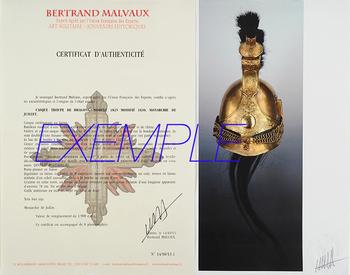
Next update Friday, april 4th at 1:30 PM
FOR ALL PURCHASES, PAYMENT IN MULTIPLE CHECKS POSSIBLE
bertrand.malvaux@wanadoo.fr 06 07 75 74 63
An authenticity certificate of the item including the description published on the site, the period, the sale price, accompanied by one or more color photographs is automatically provided for any item priced over 130 euros. Below this price, each certificate is charged 5 euros.
Only items sold by me are subject to an authenticity certificate, I do not provide any expert reports for items sold by third parties (colleagues or collectors).
